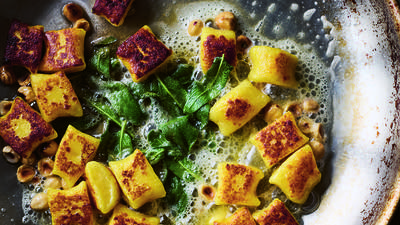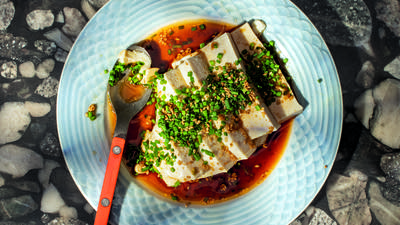
Kai Kaphrao Khai Dao
Stir-fried chicken with hot basil
It's morning in Bangkok. Motorcycles zig-zag treacherously through the lines of cars clogging the streets. You're walking along grand boulevards and down narrow side streets. Overhead, great masses of electric wires snake through the city and skyscrapers gleam in the skyline. You're hungry, searching for something to eat. But you don't have to try hard to find food, because in Bangkok, food usually finds you.
You can't go far without passing a cluster of umbrella-covered stands, selling mammoth pink segments of pomelo or skewers of meat or noodle soups. Finally, you stop at a vendor set up beside an alley, a woman presiding over more than a dozen aluminum trays, each piled with dish you can't for the life of you identify. Still, you want to eat them all.
It's in this type of restaurant, called raan khao kaeng (roughly, curry-over-rice shops), where many visitors to Thailand, not just to Bangkok, come across kai kaphrao, a stir-fry of pork or chicken seasoned aggressively with garlic, chiles, fish sauce, soy sauce, and a touch of sugar. It's a common morning food (Thais don't eat breakfast the way we do), but it's also lunch, it's a late-afternoon snack, it's whatever you want it to be. Served beside a heap of jasmine rice and perhaps a crisp-edged fried egg, it is a fine example of aahaan jaan diaw, what Thais call a one-plate meal.
The dish is defined by a last-minute dose of kaphrao (holy or hot basil), an ingredient so essential that the dish is named for it. For short, people often order it as phat kaphrao, literally "stir-fried holy basil." In the US, we'd never give top billing to an herb. Dill salad? No, it's egg salad. Grilled rosemary? No, it's a charred steak -- so what if it happens to be perfumed by a few sprigs?
The herb has a very particular flavor, to be sure, a distinctive peppery heat, but in Thailand, it's prized for its powerful aroma. The notion of aroma eclipsing flavor can sometime confound us Westerners. Ask a Thai person to describe holy basil and the first thing they'll say is hom, or "smells good." You'll notice that versions that people have cooked for themselves and their families, compared to those sold by street vendors, contain even more holy basil, which is relatively pricey in Thailand. That's one benefit of making it yourself -- you control the size of the handful. The other is being above the hot pan when you add that handful, the pleasure of being in a room overtaken by its scent.
Flavor Profile: Aromatic, salty, spicy, sweet
Special Equipment
A Thai granite mortar and pestle
A wok and wok spatula
Ingredients
2 tablespoons vegetable oil
1 large egg, at room temperature
1 tablespoon Thai fish sauce
2 teaspoons Thai black soy sauce
1 teaspoon granulated sugar
11 grams peeled garlic cloves, halved lengthwise and lightly crushed into small pieces in a mortar (about 1 tablespoon)
5 ounces ground chicken (preferably thigh meat) or pork
1 ounce long beans, cut crosswise into 1/8-inch slices (about 1/4 cup)
1 1/2 ounces peeled yellow onion, thinly sliced with the grain (about 1/4 cup)
6 grams fresh Thai chiles (about 4), preferably red, thinly sliced
3 or 4 dried Thai chiles, fried and very coarsely crumbled
6 grams hot basil leaves (about 1 cup), see Note
To Serve Alongside
1 to 1 1/2 cups Khao Hom Mali (Jasmine rice)
Phrik Naam Plaa (Fish sauce--soaked chiles), optional
Note: Holy or hot basil (bai kaphrao in Thai) is a variety of basil with a peppery flavor and distinctive aroma. To find it, your best bet is a Thai-focused market, though you might get lucky at Indian grocery stores (where the herb might be called tulsi) or farmers' markets. Beware of inaccurate labeling: I've seen "Holy basil" used to refer to purple-stemmed Thai or sweet basil.
Cook the Egg
Heat a wok over very high heat, add the oil, and swirl it in the wok to coat the sides.
When it begins to smoke lightly, crack in the egg and cook for about 5 seconds. It should spit and sizzle violently and the whites should bubble and puff. Decrease the heat to medium and cook the egg, frequently tipping the pan slightly and basting the egg with the oil, just until the white has set and turned golden at the edges and the yolk is cooked the way you like it (I prefer my yolk slightly runny), about 1 minute. Turn off the heat.
Transfer the egg to paper towels to drain, leaving the oil in the wok.
Stir-Fry and Serve the Dish
Combine the fish sauce, soy sauce, and sugar in a small bowl and stir well.
Heat the wok again over very high heat. When the oil smokes lightly, add the garlic, take the wok off the heat, and let the garlic sizzle, stirring often, until it turns light golden brown, about 30 seconds. Put the wok back on the heat, then add the chicken, long beans, onions, and fresh chiles. Stir-fry (constantly stirring, scooping, and flipping the ingredients) and break up the chicken as you do until the meat is just barely cooked through, about 1 minute.
Add the dried chiles and the fish sauce mixture (add a splash of water, if necessary, to make sure nothing's left behind in the bowl), and stir-fry until the liquid has been absorbed by the meat, 30 seconds to 1 minute more. Turn off the heat.
Just before you're ready to serve, turn the heat back to high, and once the meat is heated through, add the basil, and stir just until it is wilted and very fragrant, 15 seconds or so.
Serve with the jasmine rice, fried egg, and fish sauce--soaked chiles.
Reprinted with permission from Pok Pok by Andy Ricker with J.J. Goode, copyright © 2013. Published by Ten Speed Press, a division of Random House, Inc.
Before you go...
Each week, The Splendid Table brings you stories that expand your world view, inspire you to try something new, and show how food connects us all. We rely on your generous support. For as little as $5 a month, you can have a lasting impact on The Splendid Table. And, when you donate, you’ll join a community of like-minded individuals who love good food, good conversation, and kitchen companionship. Show your love for The Splendid Table with a gift today.
Thank you for your support.
Donate today for as little as $5.00 a month. Your gift only takes a few minutes and has a lasting impact on The Splendid Table and you'll be welcomed into The Splendid Table Co-op.




